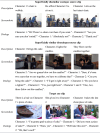The role of surface and structural similarities in the retrieval of realistic perceptual events
- PMID: 39535839
- PMCID: PMC11724687
- DOI: 10.1111/bjop.12747
The role of surface and structural similarities in the retrieval of realistic perceptual events
Abstract
This study investigated whether structural similarities (i.e. abstract frames, e.g. once bitten twice shy) can prevail over surface similarities (i.e. contexts, e.g. restaurant) in driving the retrieval of realistic events involving dynamic, multimodal and perceptually crowded data. After watching an initial set of video clips, participants had to indicate whether a new video clip, that shared surface similarities with an initial event and structural similarities with another one, elicited a retrieval. The results of Experiment 1A showed that retrieval was more likely to be elicited by structural rather than by surface similarities. Experiment 1B confirmed that the surface similarities manipulated in this study were strong enough to elicit substantial retrievals when the competing structural match was neutralized. The pattern of results obtained in Experiment 1A remained unchanged when the number of unrelated video clips within the initial set was increased. The findings suggest that structurally based retrievals still prevail when familiar structures underlie realistic perceptual events. They open new perspectives regarding the settings that promote structurally based retrievals in educational contexts where unfamiliar principles are introduced.
Keywords: analogy; ecological validity; memory retrieval; multimodality; perceptual richness; transfer.
© 2024 The Author(s). British Journal of Psychology published by John Wiley & Sons Ltd on behalf of The British Psychological Society.
Conflict of interest statement
We have no conflict of interest to disclose. The original data and study analysis code will be made available on the corresponding author's OSF account prior to publication of this manuscript.
Figures



Similar articles
-
Are Superficially Dissimilar Analogs better retrieved than Superficially Similar Disanalogs?Acta Psychol (Amst). 2020 Feb;203:102989. doi: 10.1016/j.actpsy.2019.102989. Epub 2020 Jan 18. Acta Psychol (Amst). 2020. PMID: 31958743
-
Surface matches prevail over distant analogs during retrieval.Mem Cognit. 2025 Apr;53(3):775-791. doi: 10.3758/s13421-024-01605-9. Epub 2024 Jul 11. Mem Cognit. 2025. PMID: 38992247
-
The retrieval of perceptual memory details depends on right hippocampal integrity and activation.Cortex. 2016 Nov;84:15-33. doi: 10.1016/j.cortex.2016.08.010. Epub 2016 Aug 27. Cortex. 2016. PMID: 27665526
-
Neural Pattern Classification Tracks Transfer-Appropriate Processing in Episodic Memory.eNeuro. 2018 Aug 23;5(4):ENEURO.0251-18.2018. doi: 10.1523/ENEURO.0251-18.2018. eCollection 2018 Jul-Aug. eNeuro. 2018. PMID: 30225363 Free PMC article.
-
Are There Multiple Kinds of Episodic Memory? An fMRI Investigation Comparing Autobiographical and Recognition Memory Tasks.J Neurosci. 2017 Mar 8;37(10):2764-2775. doi: 10.1523/JNEUROSCI.1534-16.2017. Epub 2017 Feb 8. J Neurosci. 2017. PMID: 28179554 Free PMC article.
References
-
- Barsalou, L. W. (1999). Perceptual symbol systems. Behavioral and Brain Sciences, 22(4), 577–660. - PubMed
-
- Berntsen, D. (2007). Involuntary autobiographical memories: Speculations, findings and an attempt to integrate them. In Mace J. H. (Ed.), Involuntary memory (pp. 20–50). Blackwell.
-
- Berntsen, D. (2009). Involuntary autobiographical memories. An introduction to the unbidden past. University Press.
-
- Blanchette, I. , & Dunbar, K. N. (2000). How analogies are generated: The roles of structural and superficial similarity. Memory & Cognition, 28, 108–124. - PubMed
MeSH terms
LinkOut - more resources
Full Text Sources

